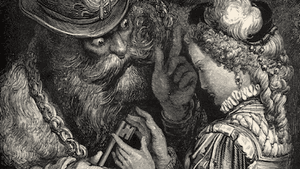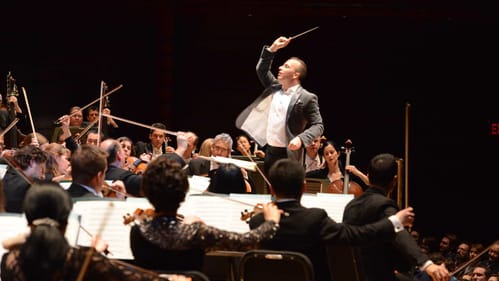Stay in the Loop
BSR publishes on a weekly schedule, with an email newsletter every Wednesday and Thursday morning. There’s no paywall, and subscribing is always free.
Operatic thrills
Philadelphia Orchestra presents 'Bluebeard's Castle' and 'Swan Lake'

Yannick Nézet-Séguin, who is about to become music director of the Metropolitan Opera, led a performance of Béla Bartók’s operatic horror story Bluebeard’s Castle, with the Philadelphia Orchestra and Met singers, for three weekend performances in Philadelphia. The production moves to Carnegie Hall on March 7, 2017.
In a conversation after Saturday’s performance, the maestro disclosed he’ll continue to perform operas in Philadelphia even while conducting at the Met. He says that’s because the Philadelphia Orchestra has a distinctive sound, and also because he’s interested in different methods of presentation. Some operas, he says, sound distinctly different with a large orchestra playing onstage rather than in a pit.
Folk song meets thriller
Such was Bluebeard’s Castle. The piece was done at the Met in 2015 with Valery Gergiev conducting. In these Philadelphia Orchestra performances, mezzo Michelle DeYoung stood to Nézet-Séguin’s left and bass-baritone John Relyea to his right. There was no scenery to distract from the confrontation between the two singers. They sing to each other but not together, illustrating their distance. Trumpets and trombones appeared in the organ loft above the stage and added power to the organ at the height of the drama.
In this psychological thriller, Bluebeard’s latest bride, Judith, coaxes him to open the locked doors inside his home. One by one, rooms are revealed, filled with instruments of torture, armaments, gold, and flowers. Each room receives its own treatment of a contrasting orchestral color.
A climax comes when the fifth door opens, here revealing a magnificent sweep of beautiful vistas; the orchestra switches from the key of F sharp (containing six sharps) to sunny C major. As the brass appeared above him, Nézet-Séguin raised a pulsating hand to signal maximum volume and projection. This is the one point in the drama where we feel something positive. Judith sees beautiful jewels and flowers, then notices drops of blood on them. I always wonder what she originally saw in this man; she sings that she believes she can bring light to his world of darkness.

Judith discovers not just Bluebeard’s possessions but facets of his persona: He’s boastful, mysterious, defensive, and occasionally passionate. They are accompanied by an orchestra that is by turns spooky, lyrical, and dissonant. The librettist Béla Balázs said, “I wanted to depict a modern soul in the primary colors of folk song.” Bartók recorded and notated hundreds of songs from villages in Hungary and Romania, which influenced this composition.
Yannick meets Ormandy
Richard Strauss’s early tone poems, which Bartók admired, were another unmistakable influence. But Bluebeard’s Castle includes elements Strauss never achieved — such as shimmering arpeggios from winds, celesta, and harp when Judith opens the sixth and final door, revealing a lake of tears. Bluebeard sings the word “tears” nine times in that scene, preparing Judith for what she’ll see when this door is opened. Then a virtual scream erupts from the orchestra just before Judith joins Bluebeard’s other imprisoned wives.
Relyea revealed a voice that in recent years has grown in depth and darkness and suits the role. DeYoung’s warm, low vocal quality also proclaimed a terrific, long-held high C when her character saw that magical kingdom.
Bluebeard’s Castle lasts only one hour, so it needs another piece on the program. Nézet-Séguin opened the concert with excerpts from Tchaikovsky’s Swan Lake ballet. Although you may see little in common between the two pieces, consider that both are based on fairytales. Both compositions also became icons of Eugene Ormandy’s Philadelphia Orchestra tenure. Ormandy frequently led performances of Swan Lake and recorded Bluebeard’s Castle (in English translation) for Columbia Records in 1960, when few conductors would touch it. Yannick loves to associate himself with the history of this revered institution. His interpretation of the Tchaikovsky had the lushness, especially from the strings, that made this orchestra famous.
What, When, Where
Swan Lake and Opera. Béla Bartók, Bluebeard’s Castle; Peter Ilyitch Tchaikovsky, Swan Lake excerpts. Yannick Nézet-Séguin, conductor; John Relyea, bass-baritone; Michelle DeYoung, mezzo-soprano. Philadelphia Orchestra. March 2-4, 2017, at the Kimmel Center's Verizon Hall, 300 S. Broad Street, Philadelphia. March 7, 2017, at Carnegie Hall, 881 Seventh Avenue, New York, New York. (215) 893-1999 or philorch.org.
Sign up for our newsletter
All of the week's new articles, all in one place. Sign up for the free weekly BSR newsletters, and don't miss a conversation.

 Steve Cohen
Steve Cohen